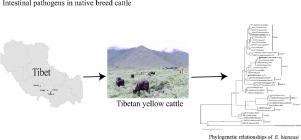Acta Tropica ( IF 2.1 ) Pub Date : 2020-08-18 , DOI: 10.1016/j.actatropica.2020.105671 Yayun Wu 1 , Yuancai Chen 1 , Yankai Chang 1 , Xiangqian Zhang 1 , Dongfang Li 1 , Lu Wang 1 , Shuangjian Zheng 1 , Rongjun Wang 1 , Sumei Zhang 1 , Jiakui Li 2 , Longxian Zhang 1

|
To assess the prevalence and molecular characteristics of Cryptosporidium spp., Giardia duodenalis and Enterocytozoon bieneusi in natural grazing local breed cattle, 513 fecal samples from Tibetan yellow cattle and cattle–yaks were tested for these pathogens. Cryptosporidium, G. duodenalis and E. bieneusi in Tibetan yellow cattle prevalence were 0.7% (3/442), 3.8% (17/442) and 2.5% (11/442), respectively. Cryptosporidium bovis (n = 3), G. duodenalis assemblages A (n = 2) and E (n = 15) were identified based on sequence analysis. Among three E. bieneusi genotypes, I (n = 7), EbpC (n = 2) and CHC8 (n = 2) detected, EbpC was classified into Group 1, which has a significant zoonotic importance, whereas genotypes I and CHC8 belonged to Group 2. None of these pathogens was identified in cattle–yaks. The presence of zoonotic C. bovis, assemblage A and EbpC indicates Tibetan yellow cattle may be a potential spread source of intestinal pathogens with a zoonotic transmission risk. The relationships between natural free–range mode and the prevalence or genetic diversity of these pathogens need be confirmed in further studies.











































 京公网安备 11010802027423号
京公网安备 11010802027423号